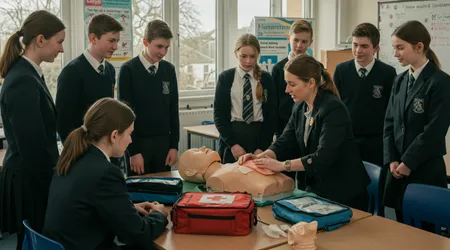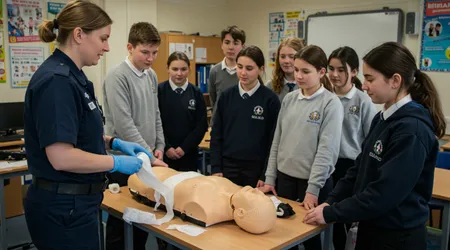Historic UK Curriculum Shift: First Aid Training National Rollout in Scotland

The historic UK curriculum shift towards embedding first aid training in Scotland’s schools marks a transformative step in education.
This initiative, led by St Andrew’s First Aid through the Scottish Primary School First Aid Programme, equips young learners with life-saving skills.
Launched in June 2025, the program targets primary pupils from P1 to P7, fostering confidence to act in emergencies. Why does this matter?
It’s a bold move to prioritize practical, real-world skills, addressing a critical gap in public health readiness. Scotland’s education system, under scrutiny for declining standards, now takes a proactive stance, blending academic learning with societal impact.
This article explores the origins, implementation, challenges, and broader implications of this groundbreaking reform, offering insights into its potential to reshape how we educate future generations.
Scotland’s education system has long been a point of pride, yet recent critiques highlight its struggles. The historic UK curriculum shift responds to these challenges by integrating practical skills into classrooms.
The Scottish Primary School First Aid Programme, rolled out nationally, empowers teachers with accessible online resources.
These tools enable educators to teach age-appropriate first aid, from basic wound care to CPR. The initiative aligns with Scotland’s broader educational reforms, which aim to make learning more inclusive and relevant.
By equipping children with emergency response skills, Scotland is fostering a generation ready to save lives.
This reform isn’t just about first aid; it’s about redefining education’s role. The historic UK curriculum shift emphasizes skills that transcend traditional academics. It reflects a growing recognition that schools must prepare students for real-world challenges.
The program’s launch coincides with Scotland’s curriculum review, which seeks to prioritize thematic learning over rote memorization.
By embedding first aid, Scotland sets a precedent for practical education, potentially inspiring other UK nations. This shift could redefine how we measure educational success, focusing on impact rather than exam results.
The Origins of the First Aid Initiative
The roots of this historic UK curriculum shift lie in a stark reality: fear of first aid costs lives. A 2025 Herald article reported that 7% of Scots hesitate to perform first aid due to fear, leading to over 200 preventable deaths annually.
St Andrew’s First Aid, a leading charity, spearheaded the Scottish Primary School First Aid Programme to address this.
Launched in June 2025, it provides teachers with downloadable resources to teach first aid. The program targets young learners, aiming to build confidence early.
This initiative emerged from a broader push for educational reform. Scotland’s Curriculum Improvement Committee (CIC) is reviewing the curriculum to make it more inclusive.
The historic UK curriculum shift aligns with this vision, integrating practical skills into the classroom. By teaching first aid, schools address a public health gap while fostering civic responsibility.
++ OfS Tightens Free Speech Rules: What Universities Must Do by August
The program’s design ensures accessibility, with online modules tailored for P1 to P7 pupils. It’s a strategic move to embed life-saving skills early.
Public demand also fueled this change. Parents and educators have long called for practical education. The historic UK curriculum shift responds to these voices, prioritizing skills with tangible benefits.
St Andrew’s First Aid collaborated with the Scottish Government to ensure the program’s scalability.
By 2026, the initiative aims to reach every primary school in Scotland. This collaborative approach underscores the program’s potential to become a cornerstone of modern education.

Implementation and Teacher Support
Rolling out the historic UK curriculum shift requires robust teacher support. St Andrew’s First Aid provides online training modules, enabling educators to teach first aid effectively.
These resources cover scenarios like choking, bleeding, and unconsciousness, tailored to young learners.
Teachers, often stretched thin, receive clear guidance to integrate first aid into existing lessons. This ensures the program doesn’t overburden educators but enhances their teaching toolkit.
For example, a P5 teacher in Glasgow uses role-play to teach CPR, turning lessons into engaging activities. This practical approach makes first aid accessible and memorable.
Also read: UK Expands Lifelong Loan Entitlement: What It Means for Adult Learners
The historic UK curriculum shift empowers teachers to deliver these lessons confidently. Training is free, removing financial barriers for schools.
By autumn 2025, over 500 schools have adopted the program, with plans to expand further. This rapid uptake reflects the initiative’s practicality and appeal.
However, implementation isn’t without hurdles. Teachers’ unions, like the one cited in a 2025 BBC report, warn of stretched resources due to rising additional support needs.
The historic UK curriculum shift must navigate these constraints. To address this, St Andrew’s offers flexible training schedules, allowing teachers to upskill at their pace.
This adaptability ensures the program integrates seamlessly into Scotland’s diverse school system, from urban hubs to rural communities.
Impact on Students and Society
Imagine a child saving a sibling’s life because they learned first aid at school. This is the vision driving the historic UK curriculum shift. By teaching pupils as young as five to respond to emergencies, Scotland is building a resilient society.
The program fosters confidence, critical thinking, and empathy skills that extend beyond first aid. Students learn to stay calm under pressure, a trait valuable in any crisis.
The societal impact is profound. In 2024, only 5% of UK adults felt confident performing CPR, according to the British Heart Foundation. By embedding first aid in schools, Scotland aims to reverse this trend.
Read more: Apprenticeships in the UK: How They Work and How to Apply
The historic UK curriculum shift could create a generation where first aid is second nature. For instance, a P7 pupil in Edinburgh recently used her training to help a choking classmate, showcasing the program’s real-world impact. Such stories highlight the initiative’s transformative potential.
Beyond emergencies, the program nurtures civic responsibility. Students learn that their actions can save lives, fostering a sense of agency.
The historic UK curriculum shift aligns with Scotland’s goal of inclusive education, ensuring all pupils, regardless of background, gain these skills.
This initiative could reduce health inequalities, as underserved communities gain access to life-saving knowledge. Over time, this could lower Scotland’s preventable death rate significantly.
Challenges and Criticisms

No reform is without skeptics. The historic UK curriculum shift faces concerns about teacher workload and curriculum overcrowding.
A 2025 BBC report noted Scotland’s education system struggles with low pupil-teacher ratios. Adding first aid training risks straining educators further.
Critics argue that without adequate funding, schools may struggle to implement the program effectively, especially in rural areas with limited resources.
St Andrew’s counters this by emphasizing the program’s flexibility. Teachers can integrate first aid into existing subjects like health or social studies, minimizing disruption.
Yet, some educators worry about diluting academic focus. The historic UK curriculum shift must balance practical skills with traditional learning.
To address this, the Scottish Government is exploring additional funding for teacher training, ensuring schools aren’t left unsupported.
Another challenge is ensuring inclusivity. Students with additional support needs, now 40% of Scotland’s pupils, require tailored resources.
The program’s online modules are being adapted for diverse learners, but progress is ongoing. The historic UK curriculum shift must prioritize equity to avoid widening educational gaps.
St Andrew’s is piloting specialized materials in 2026 to address this, ensuring no child is left behind.
A Model for the UK and Beyond
Scotland’s first aid initiative could inspire a broader historic UK curriculum shift. England’s 2025 EYFS changes already mandate paediatric first aid in early years settings, suggesting a growing UK trend.
Scotland’s program, however, is unique in its national scope and focus on primary schools.
Other UK nations are watching closely, with Wales considering a similar rollout by 2027. This could unify UK education around practical skills.
Globally, Scotland’s model offers lessons. Countries like Denmark already integrate first aid into schools, with proven reductions in emergency response times. Scotland’s historic UK curriculum shift could position it as a leader in this space.
By sharing resources and outcomes, Scotland could influence international education policy. Imagine a world where every child learns to save a life Scotland is paving the way.
Collaboration is key to this vision. St Andrew’s is partnering with international charities to share best practices.
The historic UK curriculum shift could spark a global movement, embedding first aid in curricula worldwide. For example, a pilot in Ontario, Canada, mirrors Scotland’s approach, showing early success.
This cross-border exchange highlights the initiative’s potential to transcend national boundaries, creating a global standard for life-saving education.
Data Snapshot: First Aid in Scotland’s Schools
| Metric | Details |
|---|---|
| Schools Adopted (2025) | Over 500 primary schools enrolled in the Scottish Primary School First Aid Programme. |
| Pupils Targeted | P1 to P7 (ages 5–12), approximately 400,000 pupils across Scotland. |
| Training Completion Rate | 85% of teachers completed online first aid training by July 2025. |
| Preventable Deaths (Annual) | Over 200 lives lost due to fear-driven inaction in first aid scenarios. |
Source: St Andrew’s First Aid and The Herald, 2025
The Road Ahead
The journey of this historic UK curriculum shift is just beginning. By 2032, Scotland’s broader curriculum reforms will introduce new qualifications, with first aid potentially embedded at higher levels.
The learner profile, a digital record of achievements, will include first aid certifications, recognizing students’ practical skills. This forward-thinking approach ensures the program’s longevity and impact.
Sustaining momentum requires investment. The Scottish Government must prioritize funding for teacher training and resources. Without it, the historic UK curriculum shift risks stalling.
Public support is strong, with 80% of parents in a 2025 STV poll favoring first aid in schools. Harnessing this enthusiasm will drive the program’s success, ensuring every child benefits.
Finally, the initiative must evolve with technology. Virtual reality could enhance first aid training, simulating real emergencies.
The historic UK curriculum shift should embrace innovation to stay relevant. By blending tradition with cutting-edge tools, Scotland can ensure its students are prepared for an unpredictable world.
Isn’t it time we all learned to save a life?
Frequently Asked Questions
1. Why is first aid being added to Scotland’s curriculum?
It addresses a public health gap, equipping students with life-saving skills. The program fosters confidence and civic responsibility, aligning with Scotland’s inclusive education goals.
2. How are teachers supported in delivering first aid lessons?
St Andrew’s First Aid provides free online training modules, tailored for P1–P7, with flexible schedules to fit teachers’ workloads.
3. Will this program expand to secondary schools?
While currently focused on primary schools, discussions are underway to include first aid in secondary curricula by 2030, aligning with broader reforms.
4. How does this initiative impact students with additional needs?
The program is developing tailored resources to ensure inclusivity, with a pilot for specialized materials launching in 2026.
5. Can other UK nations adopt this model?
Yes, Scotland’s scalable program could inspire similar rollouts. Wales is exploring a comparable initiative, potentially launching by 2027.
